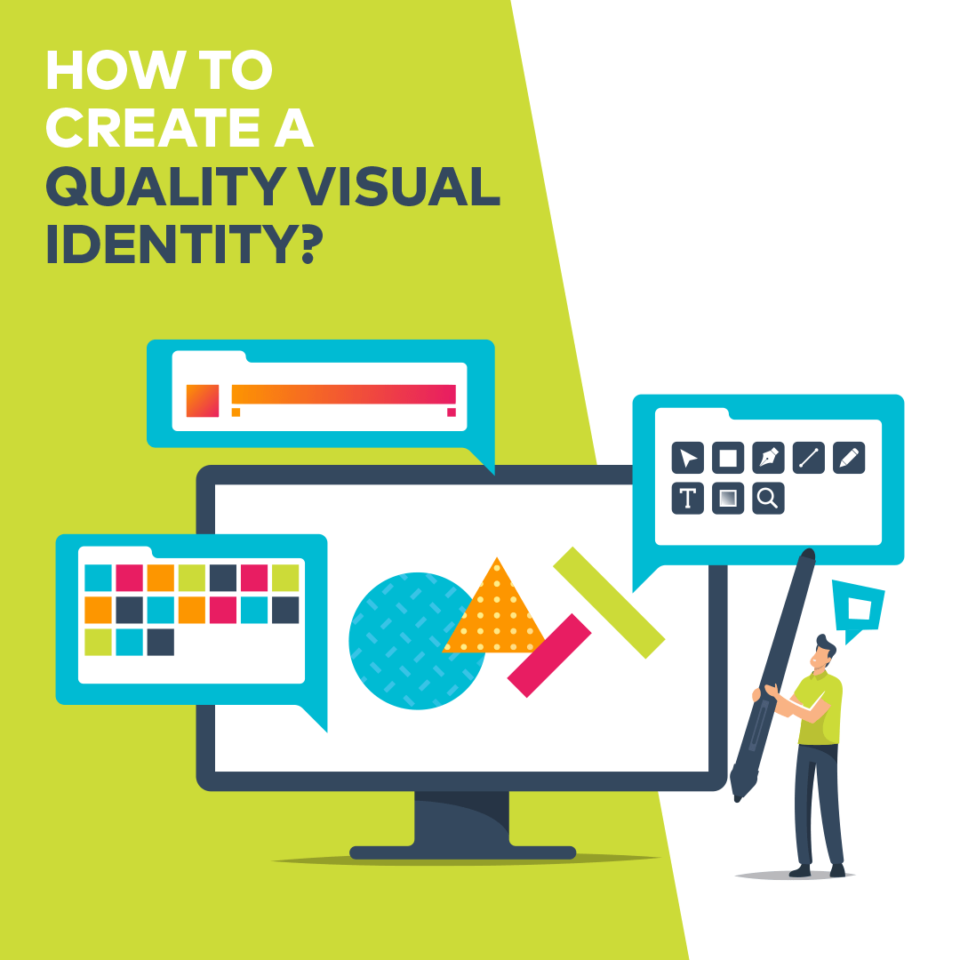How to create a quality visual identity?
What is visual identity?
Visual identity are all the images and graphics elements that express your brand and differentiate it from others. In other words, it describes everything that customers can physically see – from logos, packaging design, appearances on digital channels… to the interior design of a store or an office.
Visual identity is the way you shape the perception of your brand through visual (visible) elements. It expresses the unique characteristics of your brand and the human values that the audience can relate to, which helps them create a lasting emotional connection with your brand. A good example of that would be a visual identity that we developed as a refresh of the uWeed brand – and which was awarded as Gold winner 2022 at the MarCom Awards international competition in the Branding Refresh category.
Images are a powerful form of communication, especially because they do not communicate with words, but speak on a primordial, emotional level. However, with that great power comes the great responsibility – so we have to be careful not to send the wrong message with our visual identity. The new brand will be under the scrutiny of anyone who comes in contact with it for the first time. If we add to that the characteristic of the Internet to over-analyze and exaggerate things, by sending wrong or unclear messages we can very easily get into trouble.
Why is visual identity important for your business?
Your audience gets an impression of your company or product even before they enter your office/store or try your product/service. Most of that impression has been gained by “absorbing” the messages sent to them by your logo, packaging, campaigns, etc. That is why it is important that the visual identity reflects the brand strategy.
The strategy answers all important questions such as your goals, values, personality, tone of voice of your brand, etc, and the visual identity should show it in an adequate way to the target group. So, the visual identity is the “facade” or the face of your brand, and since the saying “beauty comes from within” does not apply in branding, it is very important what the first contact of customers with your brand will be. Messages that are inside and not visible “on the facade” will take a long way to reach customers, and on that long road you can lose a large number of potential customers. In other words, if your product has features that set it apart in the market and it is not seen anywhere in your communication, the only way for your customers to find out is to try your product. The question is how many people will buy your product without knowing its superior qualities?
Brand awareness VS Brand recognition
The visual identity of your brand is a key part of brand awareness and brand recognition. Brand recognition means that people are able to recognize the name and logo of your company and perhaps describe what you do (e.g. produce juices), while brand awareness can also include recognizing specific features that differentiate your product from the competition (e.g. juices without added sugar and water).
The reason why brand recognition is so inferior to brand awareness lies in the fact that it usually comes from a complete lack of experience with the product. In other words – people who recognize your brand are not necessarily both customers or potential customers. Nevertheless, it’s not enough for people to recognize your brand, it’s important that they also have an awareness of your brand – because by increasing brand awareness, you also increase the chances of a successful engagement with your audience.
What should we have in mind while creating the visual identity for a brand or a business?
There are no clear rules that can be applied to all products/services/campaigns, but there are a few basic things you should keep in mind when creating a visual identity for your brand.
First of all, do not start the process unprepared. Be sure to know your product and your company well and what it represents. Then, it is important to think about the brand from the customer’s perspective, because the most important thing is what your customer thinks and feels about your brand. Although it often happens that entrepreneurs build their brand according to their image, the truth is that the story of your business is not a story about you, but about your potential customers. That is why it is important to learn who the main character of your story is, and to do so before you start creating a visual identity. That is – find out about your potential customers as much as possible. Once you know what you want to promote and to whom, you can create your own brand around these concepts.
A visual brand identity is a visual representation of the value and personality of your brand. Identity design essentially sets the tone of your brand and can be used to evoke certain emotions in your audience. The visual identity of your brand should be designed to communicate the overall message of your company and promote your goals.
Developing a quality visual brand identity allows you to create a consistent message on all marketing materials. Whether you cover traditional media or digital channels with these materials, your audience must be sure that your company is behind all the materials and campaigns.
Let’s start with – why?
You compete in the market with countless other similar products/services, so it is important to stand out. A quality visual identity can help you stand out in that forest. But it is important to keep in mind that this uniqueness has two sides. On the one hand, it can help attract the attention of your potential customers, but on the other hand, if you go too far, it can lead to a misunderstanding of the message by your potential customers. So, it is not enough to be different at all costs. You need to determine what the difference is, i.e. what makes your product/service unique, or what are the so-called USP (Unique Sales Proposition) as values and characteristics that set you apart from others, and upgrade by how to visually convey it in an adequate way.
Consistent. Flexible. Digital.
When setting a visual identity, it is important to allow your brand some flexibility. We have already said that consistency is one of the important characteristics of a quality visual identity, but it is also flexibility. Basically, you need to find that thin line between a consistent performance that gives you easy recognition and the flexibility that provides space for the growth and development of your visual identity. A flexible visual identity will ensure easy application e.g. to a new product / service in the future or say creating a seasonal campaign that will be somewhat different from your overall performance.
In the last few years, digital channels have become an unavoidable part of the appearance of brands, so it would be desirable to anticipate those communication channels when creating a visual identity, i.e. you also create the so-called social media style guide. Graphic standards for social networks provide guidelines for performing on different social networks and define different aspects of this performance – e.g. look & feel photos to use, guidelines for the appearance of illustrations, how to brand posts, etc. Also, guidelines for the website (web style guide) can be defined, which will ensure that your website is part of a complete and comprehensive visual identity of your brand. All of this will ensure that your customer gets a consistent message and experience every time they come in contact with your brand, from any piece of digital content, through printed materials, to direct contact with your product.
Always trendy… is it a must?
Every year the internet is full of new trends in design which are then analyzed, monitored, copied. But the purpose of your logo is not to be trendy or cool, but to visually represent your brand. Hence, logo design should not be a business based on trends, but on the values and messages you want to communicate to your audience, as well as the information you have about your potential customers.
You are guided by creating the visual identity of your brand for the next few years (or decades). Therefore, following this year’s need in the design of the logo completely loses its meaning, since your logo will be passé next year.
Summary
– Visual identity is not just a logo
In fact, the logo is only a small part of the overall visual identity of the brand, in addition to typography, color palette, patterns, various graphic elements, photographs, illustrations, etc. Of course, the logo is the “center” of your brand’s visual identity, but being alone will not contribute to the emotional connection we want.
– The logo does not serve to be pretty
As we have said, the purpose of the logo (and visual identity as a whole) is primarily communicative. It is not there to be a decoration on a piece of paper, to have “beautiful” business cards and styrofoam advertisements. Another problem is that beauty is relative, so the big question is whether what is nice to you will be nice to your target audience to whom you want to sell your product/service.
– Consistency is a key
If, after six months of launching a new visual identity, everything seems monotonous and boring to you, it means that your performance is consistent, and that your design team is doing a good job. Every piece of material that comes in contact with your customers and potential customers (visually) in line with your identity – communicates in a defined tone, a predictable message, exactly to those you wanted. All of this can be boring for you who watch these materials every day, but it greatly contributes to the recognition of your brand, as well as to increasing engagement with your audience.
If you need support in creating a quality, consistent and flexible visual identity that will present you in the best possible light on all channels of communication for many years to come – contact us! 🙂



